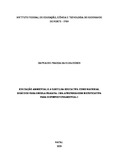Educação ambiental e a cartilha educativa como material didático para escola praiana: uma aprendizagem significativa para o ensino fundamental I
Data
2023-11-27Autor
Gomes, Daysianne França da Silva Gomes
http://lattes.cnpq.br/9313926840553831
Metadado
Mostrar registro completoResumo
The aim of this study was to investigate the themes of Environmental Education (EE) that are
most in need of dialogue in a school in a beach neighborhood and, based on this, to develop
teaching material to promote meaningful learning of environmental themes in Primary
School. The study is relevant given the lack of dialogue on environmental education in
elementary schools, as noted in the systematic literature review (SLR), and is also significant
due to the environmental problems faced by residents of the Redinha neighborhood in the city
of Natal/RN. The methodology has an applied purpose, with an exploratory and descriptive
objective, a mixed approach, deductive method, with technical procedures of bibliographic
and field research. In the field, data was obtained through observations and questionnaires
with teachers at the institution under study. The field research showed that teachers talk about
environmental education, but not often. They don't consider environmental education
activities to be superficial, but they accuse the lack of time, the lack of integration with the
contents of the curriculum, the lack of teaching materials and financial resources as being the
main challenges in carrying out environmental education. They believe that solid waste,
environmental pollution and beach care are the topics most in need of dialog within the
school. The teachers pointed out that environmental education is capable of awakening and
raising awareness among students, as well as promoting changes in attitudes and contributing
to the formation of multiplying citizens. It was clear that the teachers do not know or know
very little about the SDGs, which compromises student awareness, the consolidation of the
objectives and the consequent social transformation. In view of the results obtained during the
bibliographical and field research, a need was diagnosed for the construction of teaching
material, and the choice was made for an educational booklet with clear and accessible
language, designed to serve as an instrument to support teachers in dialoguing about
environmental issues at school, and structured according to the stages of environmental
education: awareness (I perceive), information (I learn) and action (I practice). In each topic
discussed in the booklet, a link was made between scientific knowledge and the
environmental problems faced by society. According to the teachers, the booklet is an
instrument that is easy to apply and addresses issues that are relevant to raising students'
environmental awareness.This study and the educational booklet could be an important source
of knowledge about the local reality, serving as a foundation for creating strategies and
improvements for teaching environmental education in the school context. In addition, it is
worth highlighting the importance of the multiplier effect of this study, which, based on
educational material, helped teachers to facilitate dialogue on environmental issues and
brought knowledge to students, who will be able to disseminate this information beyond the
school walls.




